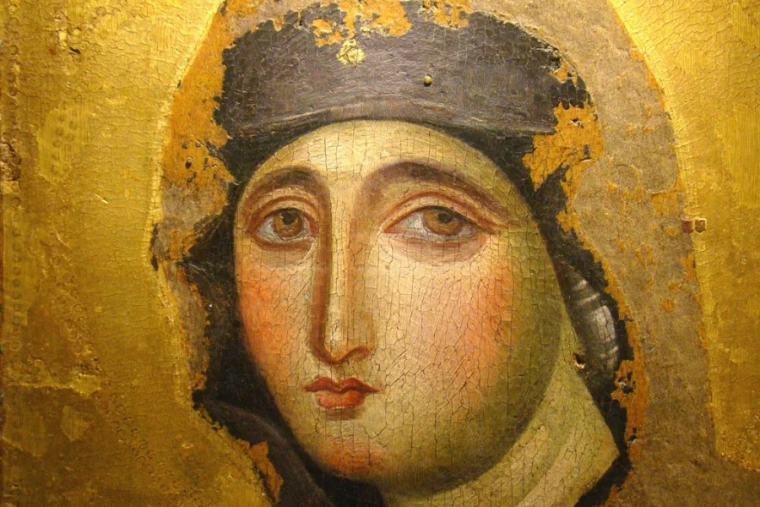I had never heard of this icon, and I thought I knew a lot about the Dominican Order, the Order of Preachers. The story goes back 800 years ago when on February 28th, 1221 St. Dominic de Guzmán established a monastery of nuns in Rome. From the Catholic News Agency, "St. Dominic entrusted this Marian icon to nuns in Rome 800 years ago":
Eight hundred years ago,
a barefoot St. Dominic carried an icon of the Virgin Mary across Rome to
entrust the Marian image to a new community of cloistered nuns, who have
safeguarded the icon within the walls of their convent to this day.
The icon, known as the “Advocata,” can be found today in a small chapel on Rome’s highest hill, in the Church of Santa Maria del Rosario on Monte Mario.
The
image is absolutely stunning. Here is
the entire image, which has been damaged.
Miraculously
the face has not been damaged, and it’s well worth cropping that part of the
painting.
My goodness, what a stately, beautiful face. Who and when was it painted? Apparently it “dates back to at least the 7th century and has been revered over the centuries as having been painted by St. Luke.” I’m not sure how it could be dated to the 7th century and be painted by St. Luke, but it says “at least the 7th century,” so who knows.
I
find it amazing that this community of nuns have kept the icon in their
possession for 800 years. According to
the article they have moved twice in those years, but careful to preserve the
icon. If the procession took place in
February of 1221and St. Dominic died in August of that year, so it was six
months before he passed away. So I went
looking through my St. Dominic biographies for this event. I couldn’t find anything but I was looking
toward the end of the biographies since it happened toward the end of his
life. But one of my Lay Dominican
sisters found it in the Augusta Theodosia Drane biography, detailed in pages
112 through 117. Let me quote some key
passages.
The most refractory of
these religious [sisters] were some who were living at the time in the
monastery of Santa Maria in Trastevere, in which was kept a celebrated picture
of our Blessed Lady, said to have been painted by St. Luke. This picture was a particular favorite with
the Roman people. Tradition said that it
had been brought to Rome, many centuries before, from Constantinople; that it
was the same that had been borne processionally by St, Gregory in the time of
the plague, on that Easter day when the words of the Regina Caeli were first heard sung overhead by the voices of the
angelic choirs. After that Sergius III
had caused it to be placed in the Lateran Basilica, but in the middle of the
night it found its own way back to the majestic old church which seemed its
chosen resting place. The possession of this
picture was no inconsiderable addition to the power and popularity of the nuns;
without it they were determined never to stir, and there seemed great difficulties
in the way of removing it. (Drane,
112-3)
Quotes
taken from The Life of Saint Dominic
by Augusta Theodosia Drane, sixth edition, Tan Books, Charlotte, North
Carolina, 1988. [First published in 1857,
London]
Well, that’s quite a story of movement, from Constantinople to Rome to the nuns to the Lateran Basilica and then miraculously back to the nuns. But Dominic proposed and convinced the nuns to relocate to the convent of St. Sixtus, associated with the Basilica of St.Sixtus, a Roman basilica dating back to the seventh century. One of St. Dominic’s most notable charism was his power of speech and persuasion, and it was evident here. Thinking on my engineering work, St. Dominic would have been a great project manager and leader. The story continues onto Ash Wednesday, which in 1221 fell on February 28th.
On Ash Wednesday, which fell that year on the 28th of February, the cardinals assembled at St. Sixtus, wither the Abbess and her nuns also proceeded in solemn procession. (115)
And
later,
Four days after, on the first Sunday in Lent, the nuns took possession of their convent. They were forty-four in all, including a few seculars, and some religious of other convents. (116)
But
the painting was still not at St. Sixtus.
Dominic waited until nightfall before he ventured to remove the picture so often named; he feared lest some excitement and disturbance might be caused by this being done in broad day, for the people of the city felt a jealous unwillingness to suffer it to depart. However at midnight, accompanied by the two cardinals Nicholas and Stephen and many other persons, all barefoot and carrying torches, he conducted it in solemn procession to St. Sixtus, where the nuns awaited its approach with similar marks of respect. It did not return; and its quiet domestication in the new house completed the settlement of the nuns. They were soon after joined by twenty-one others from various other houses, and thus was formed the second house of religious women living under the rule of St. Dominic. (117)
So the story in the book differs somewhat from the article. Nonetheless a beautiful and historic painting with quite a story.
By
the way, I posted on the book, The Life of Saint Dominic, when I first read the biography two years ago.




No comments:
Post a Comment